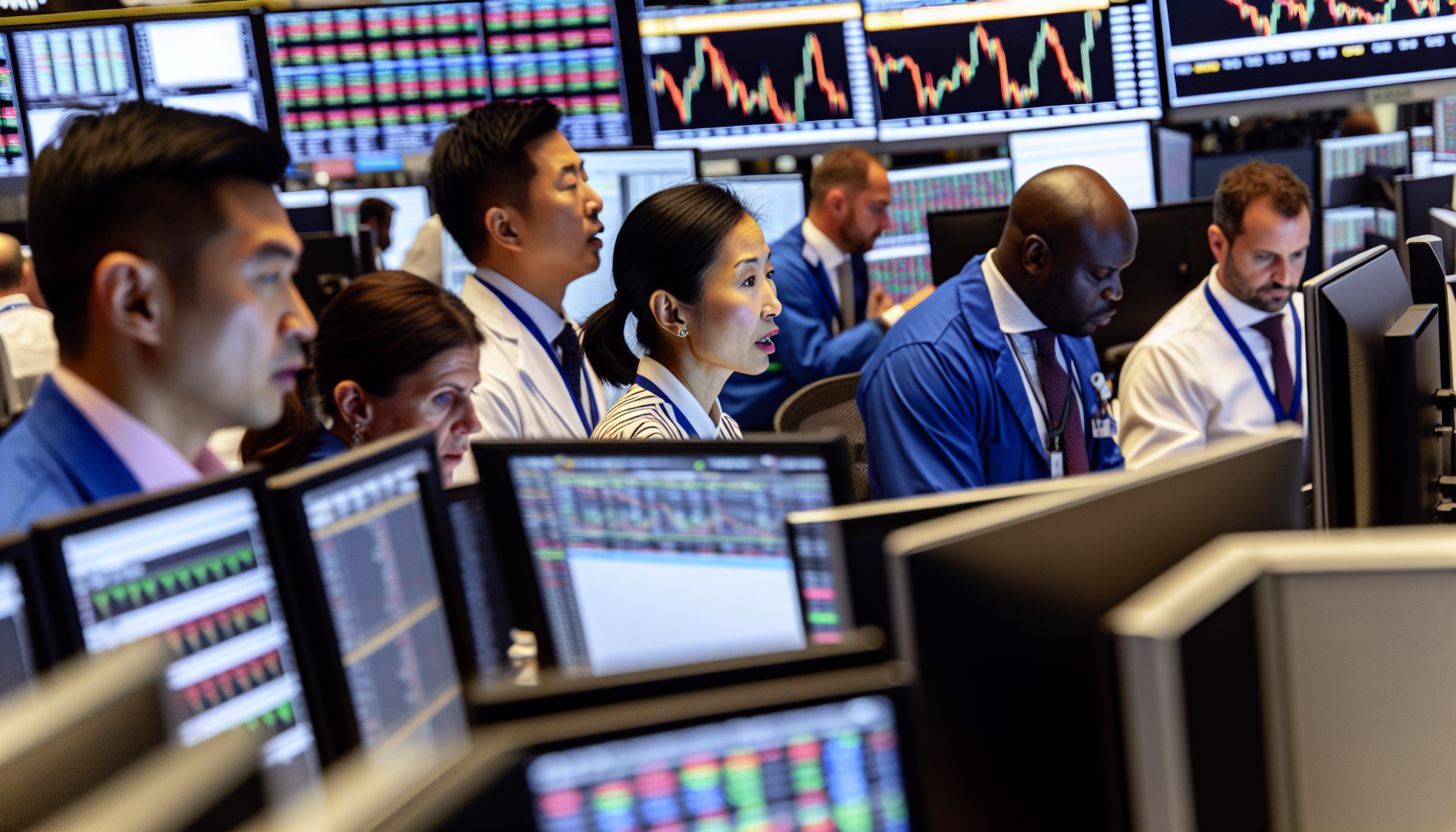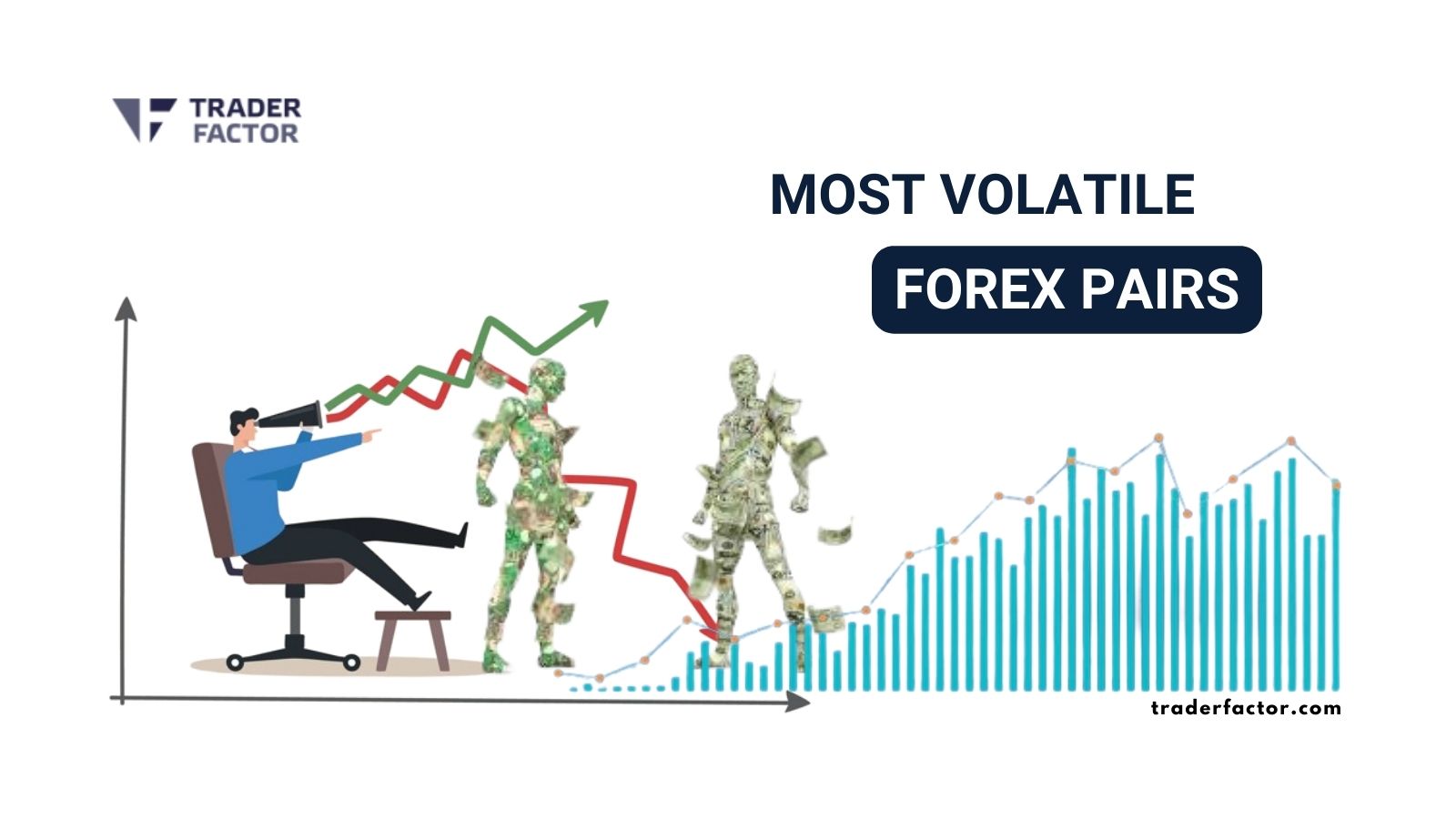What are the most volatile forex pairs? In forex trading, volatility is both a challenge and an opportunity. The most volatile currency pairs can provide traders with exciting profit potential due to their significant price movements. However, successfully navigating these turbulent waters trade forex volatility requires the implementation of effective strategies. In this post, we will explore strategies that traders can employ when trading the most volatile forex pairs, enabling them to capitalize on price fluctuations and enhance their chances of success.
One practical example of a strategy for trading volatile currency pairs is the breakout strategy. This approach involves identifying key support and resistance levels and placing trades when the price breaks out of these levels. For instance, let’s consider the EUR/USD pair, which has been trading in a tight range between support at 1.1800 and resistance at 1.1900.
A trader may wait for a breakout above the resistance level at 1.1900 before entering a long position. This breakout could signal a potentially strong upward movement. By setting a stop-loss order below the breakout level and a take-profit order at a predetermined target level, the trader aims to capture the momentum and volatility associated with the breakout.
By implementing sound strategies like the breakout strategy, forex traders can effectively navigate and capitalize on the volatile nature of forex markets. It’s important to remember that each strategy has its own advantages and requires careful analysis, risk management, and adherence to market conditions. With these strategies in your arsenal, as a forex trader, you can embrace volatility and use it to your advantage in the pursuit of profitable forex trading.

Table of Contents
ToggleKey Takeaways
Navigate market swings with strategies for trading volatile forex pairs, such as trend following, breakout trading and range trading.
Implement risk management techniques like position sizing, stop loss/take profit orders and diversification to maximize potential returns.
Utilize tools & resources including chart indicators, economic calendars & specialized platforms to stay informed of market movements.
Understanding Volatile Forex Pairs

The magnitude of the variability in forex trading is referred to as volatility. It displays the uncertainty and potential danger associated with it. This “dance of numbers” can be measured using standard deviation, which determines how much a price differs from its mean value. The most unstable currency pairs are those that have recurring shifts in their pricing values, making them highly volatile compared to low volatility pairs.
Experienced traders look for high risk/high reward opportunities by choosing these fluctuating currency pairings because they offer bigger profit margins than steady currencies do. There is an element or thrill to this method, but also requires precision planning and calculation when executing trades.
Volatility can usually be stirred up through economic indicators, commodity prices, geopolitical incidents, etc., so it’s important you pay close attention when picking your desired choice of foreign exchange rate relationships (currency pairs). For example, CAD/JPY will drastically change if oil prices alter significantly- increasing its value accordingly correspondingly often used due to surging energy costs.

Economic Indicators
Interest rates are incredibly influential to the forex markets, as they can dramatically influence a currency’s perceived worth. When interest rates rise for any given country, this often leads to an appreciation of its associated forex currency pairs, which opens up new trading prospects for investors.
On the flip side, if these same interest levels fall, it usually causes depreciation in currency price movements that particular money pair within Forex. Having knowledge and understanding about changes in involvement charges is critical when dealing with foreign exchange investments.
Inflation also has a major effect on currency volatility, concerning various major currencies pairs found inside Forex. If one specific form of tender sees inflation shoot upwards, then it’s likely we will experience higher fluctuations.
Particularly when compared against another type that displays lower levels, such factors are compared with other types that display lower levels. Tie into other economic indicators like job availability rate or manufacturing output volume etc., all contributing to unpredictability related activities taking place at FX exchanges around the world.
Commodity Prices

Exchange rate movements of the most liquid currency pairs, such as AUD/JPY and USD/ZAR can be heavily influenced by the price fluctuations of commodities like oil and gold. Referred to as commodity currencies, these are linked to countries whose economies depend on exports such as minerals or metals. When their supply and demand levels increase or decrease, so does their export value. This in turn affects the stability & exchange rates of said liquidity-heavy currency parings.
For example: The Canadian dollar’s performance is highly correlated with crude oil prices – when costs for energy rise, it takes more Japanese yen (JPY) to purchase one CAD$ unit.
Before attempting a trade involving USD / ZAR, traders must properly analyse what factors play into influencing gold prices -as that will decide how volatile & unpredictable the pair behaves over time.

Geopolitical Events
Currency pairs are significantly impacted by geopolitical events, such as Brexit. After Theresa. May’s deal was rejected in the Commons, and there were noticeable fluctuations with the GBP/EUR forex trade currency pair volatility, due to this uncertainty surrounding its departure from the EU. A similar effect can be seen with USD/TRY. These currency pairs reacted sharply to social and political issues after a failed coup d’état attempt took place in Turkey.
Trade wars also affect different currency pairs to trade areas. An example of which is Australia’s exports taking a dip when US-China relations deteriorated recently leading to AUD experiencing heightened Currency Pair Volatility within Forex Markets too. Consequently, we see that any kind of unrest has direct effects on economic stability creating considerable unease within trading sectors globally.
Identifying the Most Volatile Forex Pairs

When trading volatile forex pairs, it is important to understand how to identify them. The Average True Range (ATR) indicator or by computing the standard deviation of returns are two ways volatility can be calculated in a given currency pair depend upon. Major currency pairs such as EUR/USD, GBP/USD, USD/JPY and USD /CHF tend to have higher volatility and liquidity than cross or exotic ones.
USD/MXN, USD-BRL and especially diminished liquidity for those including but not limited exchange rates like US Dollar into Mexican Peso(e.g.
US dollars with ZAR. These less liquid currencies demonstrate amplified price fluctuation stemming from alterations in sentiment among market participants due to recent economic data releases, geopolitical events, etc. Reduced liquidity emerging market currencies may bring about increased unpredictability when trading, leading to instances of slippage along with gaps between prices.

Major Pairs
When trading in the foreign exchange market, it is essential to be aware of how economic data releases can have a considerable effect on major currency pairs. Any unexpected deviations from expectations could lead to increased volatility and should not be ignored when constructing one’s investing plan. The most highly volatile currencies are USD/JPY, USD/CHF, USD/CAD, AUD/USD, GBP/USD and EUR/USD, which see high daily turnover.
Caution must therefore be taken when dealing with these least volatile currency pairs, as they are more prone to sudden changes due to trading activity than others. Investors seeking a less risky approach might want to try least volatile currency pairs for reliability and sustainability in their trading journey. Understanding and understanding these various currencies is vital in developing an effective strategy that works best for you.
Cross and Exotic Pairs
Forex pairs, including USD/MXN, USD/BRL and other more exotic emerging market currency pairs and exchanges, have been known for their great fluctuations in prices. Significant volatility of cross currencies has generated high exchange rates appealing to traders wanting the possibility of quick profits. Emerging market pairings are typically much more unpredictable when compared with major currency combinations due to reduced liquidity.
Causing erratic price movements as well as chances of slippage or rate gaps growing significantly greater. Knowing how these factors affect trading decisions is important if one wishes to successfully execute transactions using such volatile forex pairings as those mentioned above (USD/ZAR).
Trading Strategies for Volatile Forex Pairs

After assessing the most volatile forex pairs and recognizing what affects their volatility, it is time to examine trading strategies that could take advantage of this tendency for flux. These three main tactics are trend following, breakout trading, and range trading. Each has its own set of rules with corresponding risk management protocols, understanding which is crucial before joining the dynamic world of foreign exchange markets.
Trend following attempts to get in on prolonged market motions by cohering with current trends – thus meaning buying when prices start rising or selling as they commence a descent. Hence aiming at exploiting extended pattern shifts while increasing overall profits acquired from transactions in these types of highly active and traded currencies.
Breakout trades should be combined into any system meant for handling unstable Forex pairs since providing an opportunity to enter contracts during vigorous financial motion cycles often triggering considerable cost fluctuation can result in impressive rewards if executed correctly using stop-loss orders effectively reducing risks accompanying such endeavors within FX markets making them attractive but no less hazardous than other more traditional procedures people normally think about initially engaging themselves in who’ve just started investing/trading currency related instruments

Trend Following
When trading volatile currency pairs, trend following can be beneficial because of its simplicity and potential for high returns while reducing transaction costs. To make use of the strategy efficiently, one should follow market sentiment closely and observe when there are shifts in momentum with indicators such as the ADX indicator. It is important to apply money management rules into a trading plan so that risks associated with high volatility currency pairs may be monitored.
A major advantage to applying this tactic on forex pairs includes potentially profitable results from persistent movement up or down in these assets. On the other hand, patience could prove necessary since trends need time to evolve while losses might occur more frequently during consolidation phases or reversals which means consistent analysis must take place.
Trend following has many advantages, yet potential drawbacks have not been overlooked but instead embraced due cautionary practices over uncontrolled risky attempts at profiting off volatile currency markets.
Breakout Trading
In the forex market, traders often employ breakout trading as a strategy to exploit price changes that arise when currency pairs surpass either significant resistance or support levels. With the most volatile currencies and their corresponding pairs exhibiting more pronounced trends, utilizing this method of entry is especially valuable for achieving lucrative results.
The procedure Entails examining charts with regard to existing barriers while also watching out for bullish/bearish candles developing above said thresholds. Volume checks in relation to prior bars are pertinent here too along with using applicable indicators Verifying the strength behind these breakouts.
Range Trading
Trading within a range is an approach often used in the forex market. In this strategy, traders identify and focus on certain price ranges. Buy orders are set at the bottom of said range while sell orders go to its upper end (or vice versa). This entails monitoring support levels as well as resistance ones so that trades can be placed based off these parameters. The basic premise behind it being that prices will persistently oscillate between boundaries without surpassing them too much.
Some tactics employed when trying to spot appropriate ranges for trading include: studying consolidating markets with frequent shifts inside predefined limits, looking into technical indicators like Average Directional Index (ADX) whether they correspond with some form of ranging motion from value fluctuations, examining price action data for potential pattern signs suggesting such bounds-limited activity.
These methods might help investors discern suitable times when employing range strategies seem logical or beneficial toward their goals.

Risk Management Techniques
When dealing with volatile forex and volatile major currency pairs, risk management is an integral part of forex trading. Strategies for mitigating potential losses and optimizing profit opportunities include position sizing, stop loss/take profits orders, as well as diversification. When applied correctly, these techniques are highly effective in reducing risks when investing in the foreign exchange market.
Position size calculation plays a major role concerning risk control by limiting exposure to possible monetary setbacks and protecting traders’ accounts from substantial depletion due to negative outcomes within their trades on highly volatile currency pairs or other parts of the Forex landscape.
Stop-loss/take-profit orders serve as protective measures allowing investors to create safety nets that cap profitability if markets move unfavorably but still benefit significantly should they trend favourably for them, which can be especially significant given some volatility encountered through certain types of FX strategies.
Position Sizing
Position sizing in forex trading is a means of risk management to help maximize potential profits. It entails setting up guidelines that limit the amount invested in each trade, as well as aligning with one’s risk tolerance and strategy for success. Three methods are utilized: The Max Drawdown Method, Variable Fixed Method and Percentage Method.
All suitable depending on the trader’s preferences such as their particular trading strategy or market conditions present at any given time. By utilizing effective position sizing techniques it becomes possible to effectively manage risks while ensuring gains remain high when successful trades take place.
Stop Loss and Take Profit Orders
For risk management, stop loss orders are a useful tool for closing out trades at predetermined prices or amounts. There are several types such as regular, trailing and guaranteed versions to choose from when needed. To that, take profit orders enable traders to exit their position with profits once the market reaches an agreed upon level. Both of these pieces of technology form part of the important foundation for successful forex trading strategies since they help you avoid losses and maximize gains respectively.

Diversification
In Forex trading, diversification is a strategy used to allocate investment across various currency pairs and assets in order to reduce risk exposure and protect against sudden changes in the market. This approach is important for successfully managing risks related to these types of trades. Through this method, investors can guard themselves from potential losses while increasing their chances of making profits.
Benefits such as reducing financial risk through spreading investments out over different markets, an improved probability of success with consistent returns on investments are all positives that come with adopting this tactic along with leveraging trade margin options when dealing minor currency pairs and on margin currencies has been employed by traders worldwide.
Challenges including understanding correlations between finances instruments, mitigating foreign exchange rate risk fluctuations require careful thought processes before deciding what should be included within portfolios or not ultimately creates barriers which makes it difficult at times for many individuals who may wish look into exploring financial instruments. But don’t necessarily have the technical knowledge readily available nor access particular information about asset classes prior to investing.
Tools and Resources for Trading Volatile Pairs

For successful trading of the most and least volatile forex pairs or pairs of forex pairs, it is important to have the necessary tools and resources. These comprise chart indicators such as ATR (Average True Range), Bollinger Bands, Moving Averages and Standard Deviation which can be used for gauging market volatility and finding reliable trends. Professional traders use specialized platforms like XTB or Forex.com when dealing with these highly unpredictable currency exchanges (like AUD/USD, USD/JPY and GBP/USD).
Lastly, economic calendars are extremely useful in giving information about any imminent economic events that may influence fluctuations in price levels. Thereby aiding risk management strategies based on analyzing insights from them. All together equip you better for delving into the ever-changing world of foreign exchange markets.
Chart Indicators
When it comes to analyzing volatile forex pairs, several chart indicators can be used for better prediction of price movements and identifying potential trading opportunities. These include Moving Average (MA), Exponential Moving Average (EMA), Bollinger Bands, Keltner Channel Indicator as well as the Relative Strength Index (RSI).
Bollinger bands provide technical analysis guidance about volatility along with clues regarding reversals in prices that could occur soon after. With its range from 0-100 score, RSI measures market momentum by calculating speed and intensity of price fluctuations thus helping traders make intelligent decisions when entering or exiting trades based on their own tolerance levels towards risk taking.

Especially useful when dealing with highly unpredictable and volatile currency pair exchange rate markets like those involving volatile forex pairs – this indicator provides much insight into whether a particular direction is overbought or oversold at any given time while also allowing investors to have more informed choices via clear indication on how far away they are from certain preset thresholds established before the trade was initiated initially.
Trading Platforms
For those interested in trading volatile forex pairs, the MetaTrader 5 platform offers an impressive selection of features like intricate charting capabilities and a plethora of technical indicators. Traders can take advantage of automated functions to adjust quickly to market fluctuations for successful strategic trading enabled by intensive technical analysis.
Other available platforms such as Forex.com, FXOpen, PrimeXBT and DailyFX are well-suited for volatile currency trade with access to popular combinations like AUD/JPY or USD/JPY along with NZD/JPY GBP/EUR AUDUSD and GBP/.
Economic Calendars
Keeping up with economic events that could influence forex markets is essential for making well-informed trading decisions. It’s important to stay informed about key data releases such as GDP, Non-Farm Payroll (NFP), the Consumer Price Index (CPI) and trade balance, plus Central bank announcements that can cause volatility in financial markets. An economic calendar provides a detailed timetable of market moving events, offering vital information which investors should keep track of when engaging in global currency trades.

Real-World Examples
Let’s examine some real-world examples to contextualize our discussion. One of the most significant volatile movements in Forex history was caused by the Brexit referendum in 2016, resulting in a weakened pound and heightened options volatility. Similarly, currency pairs such as USD/TRY faced large fluctuations due to social and political events occurring inside Turkey after their failed coup d’état attempt back then.
On March 15th 2023, an unexpected event occurred on the forex market – despite difficult economic indicators for America’s economy at that time, the dollar gained strength against EUR mainly because Credit Suisse shares had been declining rapidly thus devaluing them against commodity currency. This episode reveals how important it is to be informed when trading currencies in order to be able to cope with sudden changes like this one occurring unexpectedly on the forex market yet again.
Summary
Embracing the exciting world of volatile forex pairs, we have investigated the elements that contribute to their volatility, how one can go about trading them using techniques like trend following and breakout strategies as well as highlighting risk management methods. Through specific cases, we grasped both the chances for profit within this market plus what risks come with it. You can feel all of these aspects in action – numbers moving quickly, currencies racing against each other – through putting your trust into a volatile forex market. Are you ready?

Frequently Asked Questions
What pairs move 100 pips a day?
The AUD/USD pair usually fluctuates by 70-100 pips each day and 600-900 per month, depending on economic reports, changes in commodity prices or shifts in investor sentiment.
What are the most manipulated forex pairs?
Among the currency pairs most frequently traded on foreign exchange markets are AUD/JPY, NZD/JPY, AUD/USD, CAD/JPY and AUD/GBP. These major forex pairings often generate substantial volatility in prices due to their prevalence.
What is the most predictable forex pair?
The EUR/CHF pairing is the most stable currency reliable and low volatility pair for technical traders due to its consistent liquidity. This creates a safe haven currency reliable option when dealing in Forex trading.
Which currency pairs are most volatile?
When it comes to the most volatile currency pairs, AUD/USD, CAD/USD and NZD/USD are among them. These commodity currencies garner a lot of attention for their high volatility, which leads many investors to trade in them actively. On top of that, EUR/USD has the highest trading volume out of all these trading currency pairs combined due to its greater level of volatility.
What is the concept of volatility in forex trading?
Forex trading volatility is gauged by the standard deviation, which reflects how far a currency’s value fluctuates from its average. This quantifies just how much alteration in value has occurred.
Disclaimer:
All information has been prepared by TraderFactor or partners. The information does not contain a record of TraderFactor or partner’s prices or an offer of or solicitation for a transaction in any financial instrument. No representation or warranty is given as to the accuracy or completeness of this information. Any material provided does not have regard to the specific investment objective and financial situation of any person who may read it. Past performance is not a reliable indicator of future performance.















